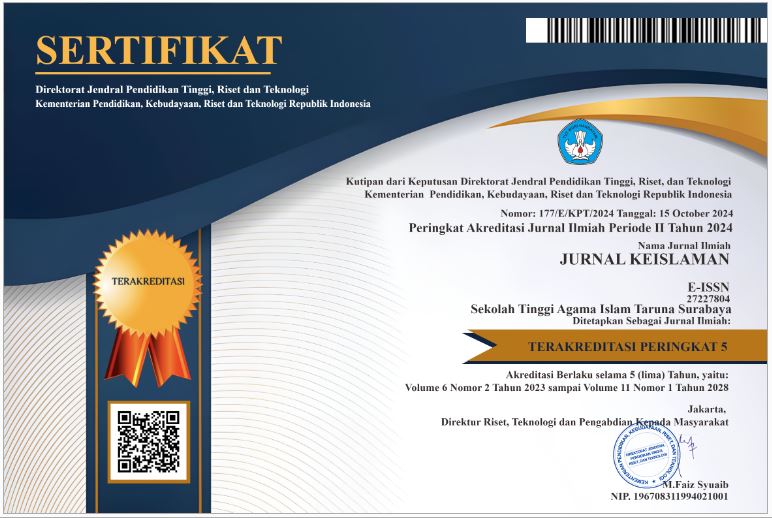Fenomena Childfree Berdasarkan Perspektif Hukum Islam Progresif, Pancasila dan Hak Asasi Manusia (HAM)
DOI:
https://doi.org/10.54298/jk.v7i1.239Keywords:
Childfree Phenomenon, Progressive Islamic Law, Pancasila, Islamic LawAbstract
The childfree phenomenon in normative legal studies is considered an aberration. Islamic law scholars refer to various considerations, ranging from being contrary to nature, not being in accordance with national culture and threatening human civilization. However, in certain cases childfree becomes an alternative because there is an element of unintentional doing it. Call it for health, psychological and other reasons. Strict restrictions on childfree practices when it is done intentionally and views having children as a burden. This research uses qualitative methods and is a library research type. Researchers use a normative legal approach in analyzing data. The analysis technique used is descriptive analytic. Data is taken from various literature such as books, journals, scientific works, official websites and related sources according to the research theme. The results of the research show that according to the progressive Islamic and Pancasila views, childfree is possible for health and psychological reasons. Apart from that, childfree is a person's private choice that cannot be interfered with by other people.
Downloads
References
Admin. “The Adults Celebrating Child-Free Lives.” https://www.bbc.com/, 2023. https://www.bbc.com/worklife/article/20230208-the-adults-celebrating-child-free-lives.
Ahdiat, Adi. “Angka Kelahiran Indonesia Turun 30% Dalam Tiga Dekade.” https://databoks.katadata.co.id/, 2023. https://databoks.katadata.co.id/.
Asmaret, Desi. “Dampak Childfree Terhadap Ketahanan Keluarga Di Indonesia.” ADHKI: JOURNAL OF ISLAMIC FAMILY LAW 5, no. 1 (July 24, 2023): 73–89. https://doi.org/10.37876/adhki.v5i1.108.
Balen, F van, and H M W Bos. “The Social and Cultural Consequences of Being Childless in Poor-Resource Areas.” Facts, Views & Vision in ObGyn 1, no. 2 (2009): 106. http://www.ncbi.nlm.nih.gov/pubmed/25478076.
Bolshunova, Tatiana. “The Childfree Phenomenon: A Macrososiological Analysis.” VESTNIK UNIVERSITETA, no. 4 (2018): 145–49. https://doi.org/10.26425/1816-4277-2018-4-145-149.
Bos, Henny, Frank van Balen, and Adriaan Visser. “Social and Cultural Factors in Infertility and Childlessness.” Patient Education and Counseling 59, no. 3 (December 2005): 223–25. https://doi.org/10.1016/j.pec.2005.08.013.
BPS. “Angka Kelahiran Total Menurut Provinsi 2012-2017.” https://www.bps.go.id/, 2023. https://www.bps.go.id/.
———. “Laju Pertumbuhan Penduduk (Persen), 2021-2023.” https://www.bps.go.id/i, 2023. https://www.bps.go.id/i.
Brkovich, A M, and W A Fisher. “Psychological Distress and Infertility: Forty Years of Research.” Journal of Psychosomatic Obstetrics and Gynaecology 19, no. 4 (December 1998): 218. https://doi.org/10.3109/01674829809025700.
Fadhilah, Eva. “Childfree Dalam Pandangan Islam.” Al-Mawarid Jurnal Syariah Dan Hukum (JSYH) 3, no. 2 (2022): 71–80. https://doi.org/10.20885/mawarid.vol3.iss2.art1.
Fauzan, Ahmad. “Childfree Perspektif Hukum Islam.” As-Salam 15, no. 2 (2016): 1–23. https://ejournal.staidarussalamlampung.ac.id/index.php/assalam/article/view/338.
Febriansyah. “Childfree Controversy in the Perspective of Islamic Law and Human Rights.” El-Izdiwaj: Indonesian Journal of Civil and Islamic Family Law 4, no. 1 (2023): 1–19. https://www.oxfordlearnersdictionaries.com/definition/english/childless?q=childless.
Gietel-Basten, Stuart, and Andrea Sze Wing Yeung. “Self-Definition and Evaluation of the Term ‘Childfree’ Among Hong Kong Women.” SAGE Open 13, no. 4 (October 12, 2023). https://doi.org/10.1177/21582440231198994.
Gouni, Olga, Gabija Jarašiūnaitė-Fedosejeva, Burcu Kömürcü Akik, Annaleena Holopainen, and Jean Calleja-Agius. “Childlessness: Concept Analysis.” International Journal of Environmental Research and Public Health 19, no. 3 (January 27, 2022): hlm. 1464. https://doi.org/10.3390/ijerph19031464.
Greil, Arthur L. Not Yet Pregnant, Infertile Couples in Contemporary America. New Brunswick: Rutgers University Press, 1991.
Hadi, Abdul, Husnul Khotimah, and Sadari. “CHILDFREE DAN CHILDLESS DITINJAU DALAM ILMU FIQIH DAN PERSPEKTIF PENDIDIKAN ISLAM.” JOEL: Journal of Educational and Language Research 2, no. 1 (2022): 180–97.
Haecal, Irfan Farraz, Hidayatul Fikra, and Wahyudin Darmalaksana. “Analisis Fenomena Childfree Di Masyarakat: Studi Takhrij Dan Syarah Hadis Dengan Pendekatan Hukum Islam.” Gunung Djati Conference Series 8 (2022): 73–92. https://conferences.uinsgd.ac.id/gdcs Analisis.
Haganta, Karunia, Firas Arrasy, and Siamrotul Ayu Masruroh. “Manusia, Terlalu (Banyak) Manusia: Kontroversi Childfree Di Tengah Alasan Agama, Sains, Dan Krisis Ekologi.” Prosiding Konferensi Integrasi Interkoneksi Islam Dan Sains 4 (2022): 309–20.
Hazyimara, Karunia. “Fenomena Keputusan Childfree Dalam Perspektif Al-Qur’an,” 2022.
Indah, Dania Nalisa, and Syaifuddin Zuhdi. “The Childfree Phenomenon in the Perspective of Human Rights and Maqashid Al-Shari’ah,” 2022. https://doi.org/10.2991/assehr.k.220501.025.
Indahni, Amelia, Maritim Raja, and Ali Haji. “Fenomena Childfree Terhadap Bonus Demografi Islam Di Indonesia.” Regalia: Jurnal Gender Dan Anak 1, no. 2 (2022): 49–58. https://ojs.umrah.ac.id/index.php/jga/.
Kusumah, Dinni Muharryani. “Childfree: Perubahan Konsep Mempunyai Anak Pada Kalangan Muda Di Jepang.” Sekolah Tinggi Bahasa Asing LIA, 2023.
Mingkase, Nursyamsiah, and Inayah Rohmaniyah. “Konstruksi Gender Dalam Problematika Childfree Di Sosial Media Twitter.” Yinyang: Jurnal Studi Islam Gender Dan Anak 17, no. 2 (November 15, 2022): 201–22. https://doi.org/10.24090/yinyang.v17i2.6486.
Mubarak, Jihan Salma, Eva Meidi Kulsum, and Wahyudin Darmalaksana. “Syarah Hadis Seputar Fenomena Childfree Di Indonesia Dengan Pendekatan Ijmali.” Gunung Djati Conference Series 8 (2022): 270–82. https://www.conferences.uinsgd.ac.id/index.php/gdcs/article/view/571.
Muhammad, Rusdi. “Konsep Childfree Dalam Perspektlf Hukum Islam Dan Hak Asasi Manusia.” UIN Antasari Banjarmasin, 2023.
Nasiri, Nasiri. “Marriage in Morocco: A Practices of The Mudawwanatul Usrah Law in The Land of Guardians.” International Journal of Islamic Thought and Humanities 1, no. 1 (March 1, 2022): 27–39. https://doi.org/10.54298/ijith.v1i1.13.
Ph.D., Ellen Walker. “Childfree Trend on the Rise: Four Reasons Why!” https://www.psychologytoday.com/, 2014. https://www.psychologytoday.com/us/blog/complete-without-kids/201401/childfree-trend-on-the-rise-four-reasons-why.
Rahmadanti, Kartika Amelia. “Childfree Menurut Undang-Undang Nomor 39 Tahun 1999 Tentang Hak Asasi Manusia.” IAIN Kediri, 2022.
Rizka, Muliya, Kurnita Yeniningsih, Mutmainnah, and Yuhasriati. “Childfree Phenomenon in Indonesia.” Proceedings of The 11th Annual International Conference (AIC) on Social Sciences. Banda Aceh: September 29-30, 2021, 2021, 336–41.
Sa’dan, Masthuriyah. “Perkawinan Beda Agama: Perspektif Islam Progresif.” Kontemplasi: Jurnal Ilmu-Ilmu Ushuluddin 4, no. 2 (2016). https://doi.org/10.21274/kontem.2016.4.2.317-336.
Samsudin, Titin, Yessy Kusumadewi, Mutiarany, Louisa Yesami Krisnalita, and Verawati Br Tompul. “Childfree Is a Form of Desecration of the Purpose of Marriage.” Jurnal Hukum Dan HAM Wara Sains 2, no. 03 (2023): 172–80. https://doi.org/10.58812/jhhws.v2i03.247.
Saragih, Arni Amanda, and Syofiati Lubis. “Generasi Gen Z Dan Childfree Di Indonesia Berdasarkan Undang- Undang Nomor 39 Tahun 1999 Tentang Ham : Studi Perspektif Fiqih Siyasah.” EDUCATIO: Jurnal Pendidikan Indonesia 9, no. 2 (2023): 870–76.
Siswanto, Ajeng Wijayanti, and Neneng Nurhasanah. “Analisis Fenomena Childfree Di Indonesia.” Bandung Conference Series: Islamic Family Law 2, no. 2 (August 6, 2022). https://doi.org/10.29313/bcsifl.v2i2.2684.
Sujarwo. “Trend Bebas Anak Child Free Di Kalangan Pasangan Milenial Pasca Menikah.” Edukasi IPS 01, no. 1 (2017): 12–20.
Syarifah, Maisyatusy, and Hudzaifah Achmad Qotadah. “Childfree In The Qur’an: Reinterpretation of Al-Naḥl Verse 72 With Ma’nā Cum Maghzā Approach.” Al-Tahrir 22, no. 2 (2022): 325–42.
Taqwim, Ahsani. “Memilih ‘Child Free’ Di Ruang Publik Digital Yang Dipenuhi Kemarahan.” Kompas.com, 2023. https://www.kompas.com/tren/read/2023/02/20/080000365/memilih-child-free-di-ruang-publik-digital-yang-dipenuhi-kemarahan?page=all.
Vaishnav, Jankeedevi, Clinical Psychologist, and Mental Health. “The Dilemma of Infertile Couples and Their Mental Health” 10, no. 12 (2022): 844–61.
Webster, Kamus Merriam. “Definisi Child-Free,” 2023. https://www.merriam-webster.com/dictionary/child-free.
Zulaikha, Siti. “The Childfree Phenomenon in Some Influencers.” ARRUS Journal of Social Sciences and Humanities 3, no. 1 (2023): 59–64. https://doi.org/10.35877/soshum1666.
Downloads
Published
How to Cite
Issue
Section
License
Copyright (c) 2024 Chairul Majid Nasution, Gusti Rian Saputra

This work is licensed under a Creative Commons Attribution-ShareAlike 4.0 International License.
Authors who publish with this journal agree to the following terms:
- Authors retain copyright and grant the journal right of first publication with the work simultaneously licensed under a Creative Commons Attribution-ShareAlike 4.0 that allows others to share the work with an acknowledgement of the work's authorship and initial publication in this journal.
- Authors are able to enter into separate, additional contractual arrangements for the non-exclusive distribution of the journal's published version of the work (e.g., post it to an institutional repository or publish it in a book), with an acknowledgement of its initial publication in this journal.
- Authors are permitted and encouraged to post their work online (e.g., in institutional repositories or on their website) prior to and during the submission process, as it can lead to productive exchanges, as well as earlier and greater citation of published work (See The Effect of Open Access).


















